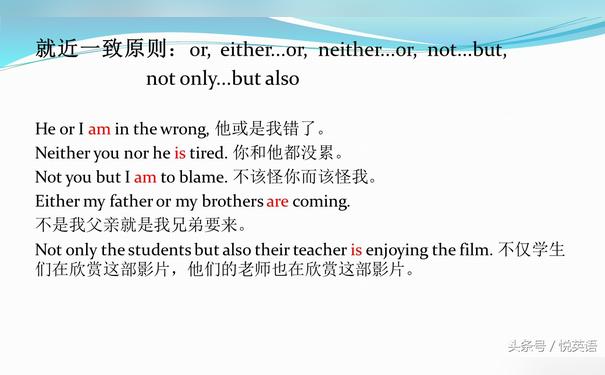一、归纳英语中就近原则和就远原则的词组?
就近原则:
由下列词语连接的并列主语:"there be+句型; or ; either …or;nor; neither…nor;whether…or;not…but; not only…but also" ;等。
例句:
1、What he does or what he says does not concern me.
他的行为或言谈都与我无关。
2、Neither you nor I am wrong .
你和我都没错。
3、Not you but your father is to blame.
不是你,而是你的父亲该受责备。
4、Not only you but(also) he is wrong.
不仅你错了,他也错了。
就远原则:
由 or,not only … but also …, either … or …, neither … nor …,not … but …等连接两个名词作主语时,谓语动词的单复数形式要根据就近原则来确定。
例句
1、Nobody but two students is in the classroom.除了这两个学生,没有人在教室
2、Everybody except you is down on me. 除了你,大家都看不起我。
3、A woman with two children has come. 一位妇女带着两个孩子已经来了。
4、John, rather than his roommates, is to blame. 约翰,而不是他的室友,应该受到责备。
二、together with是什么原则?
①
together with是副词短语,引导的是修饰语,谓语动词要跟着主语走,例如:
1、Management should get together with the union.资方应与工会在一起开个会。
2、Poverty and illiteracy go together with high birth rates.贫困、文盲与高出生率密切相关。
3、He fastened the papers together with a paper clip.他用回形针别好了文件。
②
together with遵循就近原则。
together with是副词短语,引导的是修饰语,谓语动词要跟着主语走。
together with的用法:
1、together with和,加之,带有总和的意思。
2、together with的前后都有逗号隔开,就是很明显的插入语的标志。
3、togther通常用在句尾,together with后面要加宾语。
就近原则
1、在here,there等引导的倒装句中,当主语不止一个,此时谓语动词与最靠近它的主语在数上一致喔。
例:There is a pencil and several photos on the desk.桌上有一支铅笔和几张图片。
2、连词or,either…or…,neither…nor…,not only…but also等连接的并列主语,谓语动词只与靠近它的主语在数上一致哈。
例:Either you or he knows something about the task.要么你,要么他知道此任务的相关情况。

